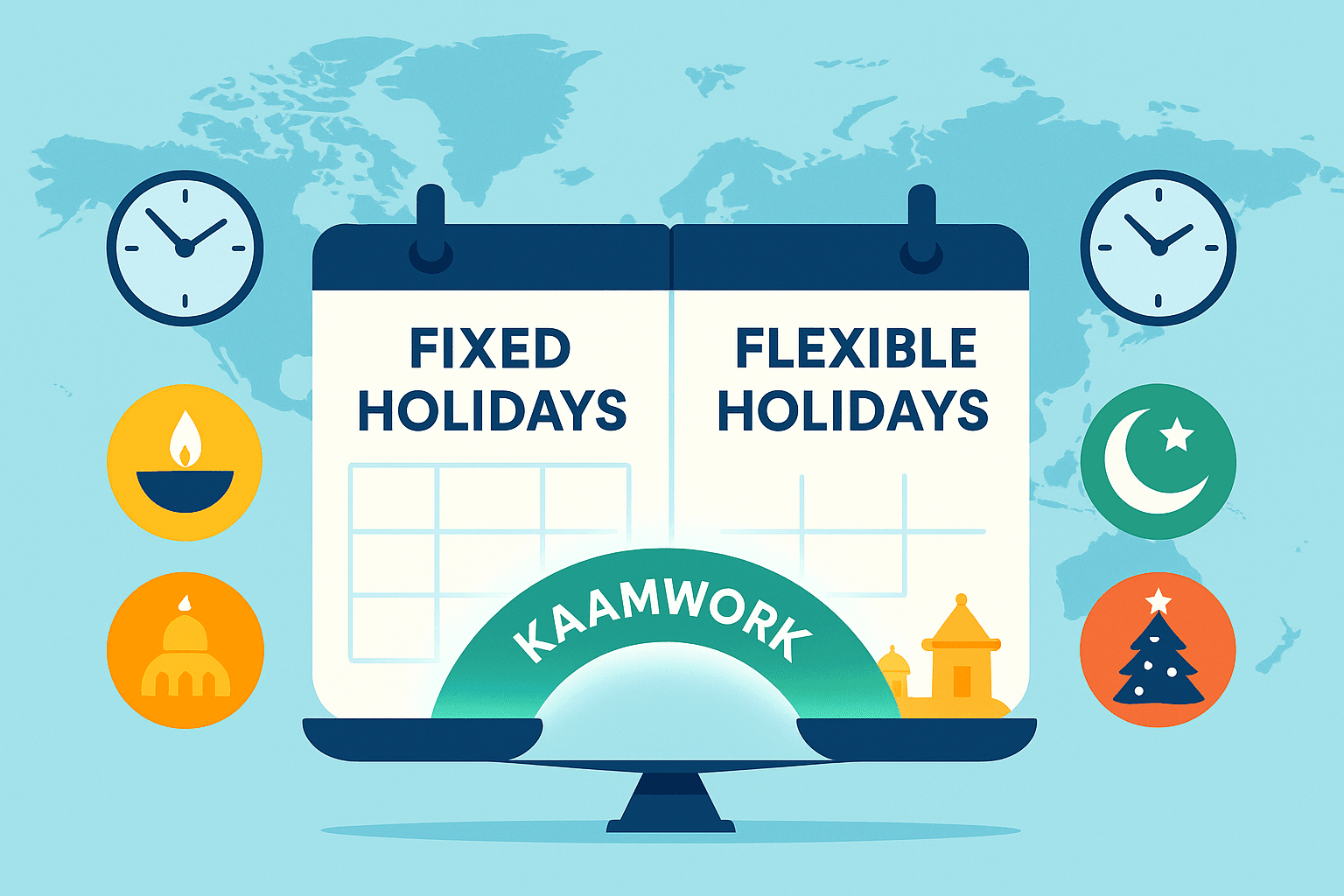Building teams in India? Here’s what restricted holidays mean for your employees
Learn how restricted holidays impact team building in India, ensuring compliance, boosting employee engagement, and streamlining HR management for global businesses.
ByNilesh@kaam.work / October 29, 2025 / 8 min read

Have you ever noticed that your India team shut down unexpectedly for a few days during a project sprint, just as everything appeared to be going smoothly? While establishing teams in India, many American founders, HR directors, and operations chiefs may experience India's significantly diversified vacation system for the first time. It's both thrilling and occasionally perplexing. But being aware of it is essential to managing precisely and leading with empathy.
One concept that always sparks curiosity is the “restricted holiday.” What is it, and why does it matter? Turns out, this small piece of policy carries big weight for your team’s happiness, your payroll accuracy, and your compliance record.
Let's examine what restricted holidays are, why they are in place, and how to handle them effectively, particularly with the help of contemporary EOR/Build models like Kaamwork that make the process seem simple.
Introduction
Hiring and managing teams in India brings endless opportunities—talent depth, time zone synergy, and up to 50% savings in operating costs—but also a few HR nuances that global leaders need to understand early. Leave management and holiday compliance are among them. What looks like a regular administrative process on paper actually reflects India’s cultural mosaic in practice.
While the U.S. may be used to a defined federal holiday calendar, India’s system is multi-layered—national holidays, state holidays, local observances, and restricted holidays (sometimes called optional holidays). If this sounds complex, don’t worry. Once you understand the logic behind it, managing it becomes quite straightforward.
Holiday policies affect employee satisfaction, operational stability, and even payroll. For distributed or hybrid Indian teams, clarity prevents confusion—and compliance keeps you in good standing with labor law. As Kaamwork often helps clients realize, the right HR structure turns complexity into clarity within days.
What is a restricted holiday in India?
Definition, simply put
A restricted holiday (RH) is an optional, paid day off that employees can choose from a pre-approved list prepared by their employer. On these days, the office remains open—only those who select that particular date take the holiday. Everyone else works as usual.
Think of it as a “flexible holiday policy” rooted in cultural respect. Instead of everyone observing the same holidays, each employee can choose two to three days yearly for festivals or observances that matter to them personally—whether it’s Eid, Diwali, Christmas, Onam, or regional harvest celebrations.
This approach celebrates India’s cultural pluralism. It gives companies stability and employees agency—a win-win balance that few other systems achieve.
How restricted holidays differ from gazetted holidays
RHs promote productivity in addition to flexibility. While the nation shuts down only on gazetted holidays (Republic Day, Independence Day, Gandhi Jayanti, etc.), you retain operational continuity. There’s no complete business halt, even as you grant cultural space to your workforce.
Restricted days are private; national days are set. A consistent rhythm is achieved by striking a balance between these: around two to three customizable RHs and ten to twelve official holidays annually. For scattered companies with clients located in different time zones, this framework preserves project momentum while respecting variety.
India distinguishes between gazetted (mandatory) holidays and restricted (optional) ones:
| Holiday Type | Mandatory? | Who Decides? | Office Status | Examples |
|---|---|---|---|---|
| Gazetted Holidays | Yes | Government (Central/State) | Closed | Republic Day, Independence Day, Gandhi Jayanti |
| Restricted Holidays | No | Employee (from an approved list) | Open | Diwali, Christmas, Eid, Onam, Holi |
If you’re running teams across different regions, gazetted holidays are observed by everyone, but restricted ones depend on individual choice. For HR leaders used to standardized calendars, it’s a shift in mindset, but one deeply appreciated by diverse workforces.
How many restricted holidays are employees entitled to?
While there’s no national mandate fixing the number, most organizations allow 2 to 3 restricted holidays per year—a guideline derived from central and state government rules.
- Most organizations allow 2–3 restricted holidays (RHs) per year, following central and state government guidelines. The Central Government provides 14 gazetted holidays and 2 optional RHs, while states and private companies may offer up to 3–4 RHs to give employees flexibility.
- Employees usually choose their RHs early in the year through HR systems. This lets one team member celebrate Onam while another takes off during Christmas week, honoring diverse cultural practices without disrupting business operations.
Employees choose their days early in the year through HR systems. It’s common to see one person celebrate Onam while another takes off during Christmas week—all within the same team. For global managers, this decentralized flexibility prevents large-scale shutdowns while honoring local cultures.
Why does India follow this system?
India is one of the world’s most diverse countries—multi-religious, multilingual, and multiethnic. Across 28 states and hundreds of linguistic communities, festivals abound. A rigid, one-holiday-fits-all rule would make work calendars chaotic. The restricted holiday framework emerged as a balanced solution: it honors diversity without flooding the work year with countless breakdays.
Think about this: Every year, India commemorates over 1,000 festivals, ranging from Lohri in the north to Onam in the south. For employees, each has a personal significance. Fairness and inclusion are guaranteed by the RH method without overtaxing business calendars.
It serves as an engagement tool for you as an employer. Employees provide a sense of belonging to the workplace when they are acknowledged and valued for their contributions to the culture. It's a kindness gesture that frequently improves retention, not merely a policy.
Why should international teams be concerned?
Payroll and compliance implications
Ignoring India's complex holiday system may put you at risk of noncompliance. RHs are formally documented time off that appears in certain states' statutory HR registers. Payroll difficulties that are not adequately recorded or maintained may result in employees being overpaid or underpaid.
False leave documentation may have an impact on:
- Calculations of salaries
- Bonus eligibility and encashment of leaves
- Reports on attendance or overtime
- Transparency in auditing
Built-in compliance routines on platforms like Kaamwork reduce these kinds of problems. To prevent financial uncertainty, municipal regulations automatically control each limited holiday that is applied for or authorized.
Employee engagement
Restrictions on holidays may not seem like much, but they have a big effect on morale. Allowing employees to celebrate meaningful events helps build trust and cross-cultural understanding. For global leaders, it’s a chance to move beyond “policy compliance” into people's experience.
Think of it this way: your U.S.-based engineer might never know what Onam feels like, but when she sees her Indian colleague take pride in it, that exchange deepens the connection in your distributed culture. Small policies, big outcomes.
Aligning workflows with the global HQ
Ever had a sprint stall because your India team was offline during Diwali? That’s the gap RH awareness aims to close. Leaders who plan for cultural calendars experience smoother global delivery. Coordinating around RHs avoids missed deadlines and helps plan workload handovers before long festivals. This helps avoid any missed deadlines or mismanagement in any project.
How restricted holidays work in practice
Standard company policy
Most Indian employers release a Holiday Calendar at the start of the year. It includes:
- Gazetted Holidays (fixed across the nation or state)
- Restricted Holidays List (a broader pool the employee can choose from)
Employees then pick their personal RHs during onboarding or at year start. They submit them on HR platforms which sync the information with payroll.
Let's take an Example:
Nisha chooses Diwali and Raksha Bandhan. Ali selects Eid and Milad-un-Nabi. The office stays open for both, but those individuals enjoy their chosen festivals—without confusion or loss of pay. It promotes individuality and access to enjoy festivals without hampering work.
Regional/state variations
Karnataka’s RH list differs from Maharashtra’s; Kerala’s differs from Delhi’s. Some states also trade dates based on lunar calendars. Managing multiple lists can quickly overwhelm HR for multi-location teams—which is exactly where structured partners like Kaamwork step in, ensuring every local rule is implemented accurately.
Common challenges global teams face
- Multi-state compliance: Each office may follow different gazetted lists.
- Remote employee diversity: Individuals scattered across India apply RHs from distinct calendars.
- Manual tracking errors: Without a unified HR platform, payroll firms can miscalculate compensatory leaves.
Although there is some complexity, it can be resolved with proactive communication and centralized tools.
How Kaamwork makes managing holidays and compliance easier
By offering a consistent compliance framework customized to your policy, Kaamwork removes all uncertainty. Imagine having your India staff up and running from Day Zero, with payroll linked and all statutory holidays and regional variances taken into account. That is the benefit of Kaamwork.
Transparent HR framework
Holiday entitlements, including RHs, are integrated into the Build-Operate-Transfer model. Employees see their complete holiday list, and you see transparency across teams—no hidden markups or confusing spreadsheets.
Integrated team experience
Employees who are onboarded under your brand feel like they belong to your culture rather than being contracted out. A clear, equitable holiday schedule fosters a sense of community and harmonizes India operations with headquarters culture.
Compliance assurance
Everything complies with Indian labor regulations, including salary, provident funds, and gratuities (which are equivalent to severance and retirement savings in the United States). You maintain complete team control while Kaamwork takes care of the paperwork.
Beyond outsourcing
Unlike outsourcing vendors that obscure staff details, Kaamwork’s EOR approach keeps ownership yours. You hire directly; Kaamwork manages local compliance—including those nuanced RH lists that can otherwise derail your payroll if ignored.
Best practices for managing restricted holidays
It's not as hard as it seems to get RHs properly. Take these useful actions:
- Release a single calendar: Early in the year, announce both gazetted and limited holidays.
- Arrange the workloads: Plan vacations, sprints, and launches around India's main holiday seasons.
- Employ HR technology: To prevent manual approval catastrophes, automate tracking.
- Honor the variety of holidays: Instead of prescribing favorites, encourage staff members to choose festivals that they genuinely enjoy.
- Interact with people around the world: To avoid overlap tension, assist US teams in understanding India's vacation schedule.
- Remain in compliance: For state updates, review leave policies once a year.
These actions eventually transform holiday management into a competitive advantage, demonstrating astute leadership that your Indian staff finds very appealing.
Holidays without the headache
When managed well, holidays become an invisible harmony in your company's rhythm. When ignored, they can trip up even the best-run operations. Restricted holidays reflect India’s beautiful complexity—and your ability to embrace it defines your success in building teams here.
You won't ever have to worry about missing updates or incorrectly labeled leave with Kaamwork's transparent and compliant EOR architecture. You get the speed and control of direct hiring, with the relief of seamless HR support behind the scenes. Everything is managed by the team, and you can enjoy your holidays without worrying much or having a headache.
Conclusion
Holiday laws convey a message about inclusivity, respect, and how multinational corporations adjust to local conditions. Understanding what a restricted holiday in India entails requires knowledge of both law and culture. It demonstrates to your staff that you respect their individuality.
Treat RHs with the same consideration that you give to your employment process when you expand your business in India. Make use of resources, collaborators, and procedures that respect belonging and business. Additionally, Kaamwork offers the bridge—your team, your brand, supported by smooth local operations—if you're prepared to expand your workforce in India without having to worry about complicated schedules, payroll compliance, or HR management.
Because in the end, building teams is more about relationships than agreements, and Kaamwork helps you do just that.
Quick FAQ for global employers
- What is the required number of limited holidays?
Typically, 2–3 per year; the exact number is set by your company or state regulations.
- Can an employer deny a restricted holiday request?
Not if it’s chosen from an approved list and applied within the notice period. Operational exceptions are rare.
- Do RHs vary by state?
Yes—states define their own lists each calendar year through local gazettes.
- What happens if employees don’t use all their RHs?
They lapse after year-end, unlike accumulated annual leave.
- Do MNCs in India observe both RHs and gazetted holidays?
Yes. It’s best practice for compliance and engagement across distributed teams.



